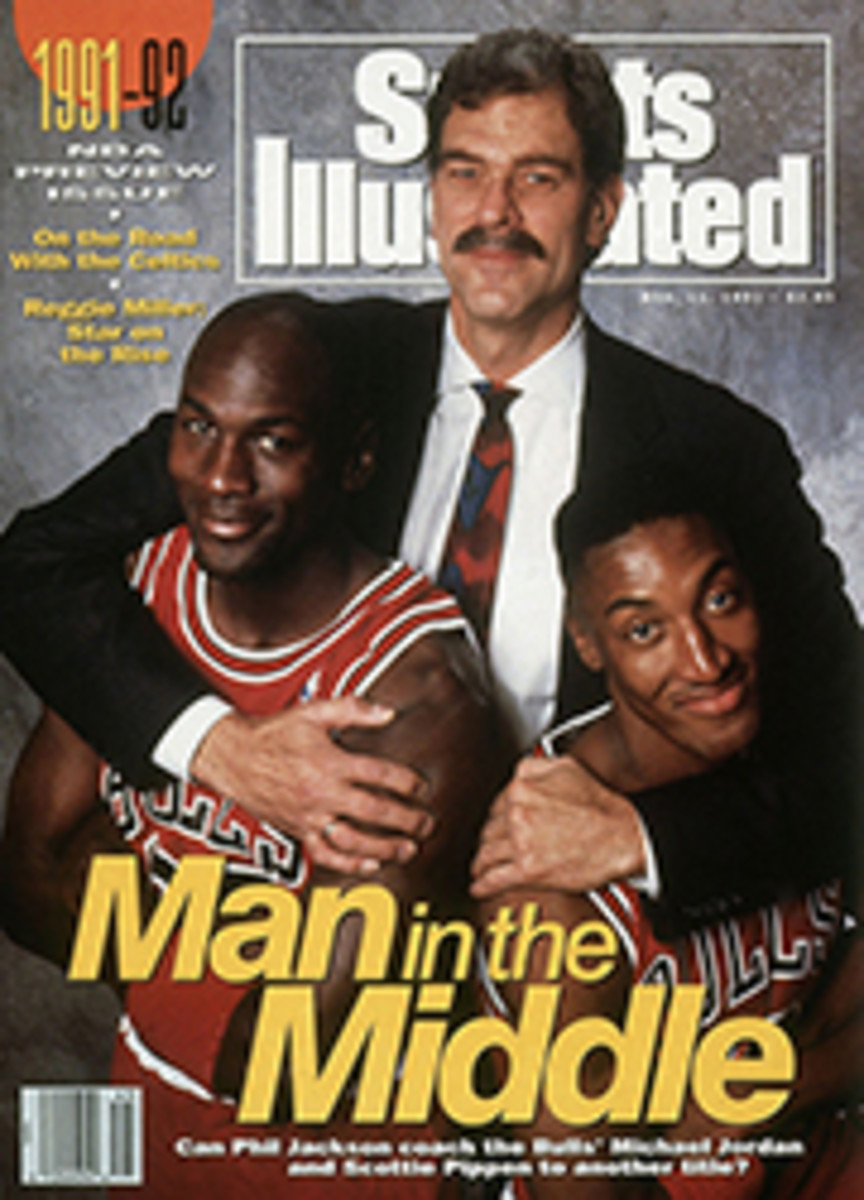
When the Court Was a Cage
Here is the pop quiz for today. A eager is:
1) a lion tamer
2) a four-wall handball player
3) a basketball player.
If you answered 3, then you're a fan of a certain age—gray, or at least graying at the temples—because a quarter century ago, basketball players were often called "cagers" and their sport was the "cage game" in the newspapers. The terms were useful shorthand for harried headline writers, most of whom probably had no idea how they had originated.
The words go back to basketball's Stone Age and the first professional players. Nearly everyone is familiar with the sport's beginnings, 100 years ago. James Naismith, a physical education instructor at the YMCA training school in Springfield, Mass., needed a challenging game to amuse a bored gym class, so he invented basketball. A scant five years later, in 1896, the first acknowledged professionals took the floor in Trenton, N.J. Their court, in a social hall, was enclosed, literally, in a cage, a 12-foot-high wire-mesh fence set along the endlines and sidelines.
At the time, the cage made good sense. Front-row spectators sat even closer to the court than they do today, and Naismith's original rules said that when the ball went out of bounds, the first player who got to it could throw it back in. Obviously, it would have been disastrous to allow players to wrestle in the laps of paying customers for possession of the ball. With the cage the rule was moot—the ball never went out of bounds.
The out-of-bounds rule was changed in 1902 to eliminate sideline scrimmages, but by that time the early pros were wedded to the cage. The thinking was that the game was faster and more entertaining in a cage because there were no delays to return the ball to play, and because the ball and the players could bounce off the wire mesh. Rope netting, a cheaper material, soon replaced the wire mesh as the cage material of choice.
Many eastern professional teams played in cages until 1925, and a few continued using them well into the '30s. Cages were rarely used outside the Northeast and never by high school, college or AAU teams. Still, the term eager was commonly used to describe all basketball players.
The original reason for using a cage was largely forgotten by the 1920s; many professionals of the time believed its purpose was to protect players from enraged fans. They had ample reason: Pro basketball in the '20s was no place for shrinking violets. It was considered fair play to drive the man with the ball into the wire or rope, especially if he was shooting. When a home-team player was thus clobbered, it was not unusual for fans to join the resulting fray. The players entered and left the cage through doors at either end, and fans sometimes fought their way in using the same openings.
Playing in cages left its imprint on the pros, literally. The late Joel S. (Shikey) Gotthoffer, a star during the 1930s for the famed Philadelphia Sphas who also played for Nanticoke in the Penn State League, once said, "I played the first few games at Nanticoke in a [rope] cage, and I came home with the cage's markings on me. You could play ticktacktoe on everybody after a game because the cage marked you up; sometimes you were bleeding and sometimes not. You were like a gladiator, and if you didn't get rid of the ball, you could get killed."
The late Joseph K. Schwarzer, who played in the New York State League in 1919, once described what happened when he came home after his first game in a rope cage. He took off his shirt and exposed rope burns all over his back. "Oh, my god," his wife exclaimed, "you've been in a fight!"
On the other hand, Albert Cooper Jr., who played in both wire and rope cages in the Trenton area, believes that basketball was safer inside the cage than out of it. Cooper says, "I played in cages up to 1929, when they stopped using them in Trenton. When they eliminated the cages, I never cared for basketball after that. All of the basketball players in those days enjoyed playing in a cage because there was less chance of injury than there is today. You learned to protect yourself. If you got jammed against the cage, it didn't bother you."
The cage wasn't originally designed to be a factor in team strategy, but smart players learned to use it to tie up a man with the ball. The late J. Emmett (Flip) Dowling, a 6'1" center in the New York State League in the early 1920s, said, "It was common practice if the man with the ball was near the net, you would grab the net on both sides of him and press him into the net so he couldn't pass the ball and they'd have a jump ball. Otherwise, the cage didn't make much difference in how the game was played."
The pro game of Dowling's era would scarcely be recognized by current NBA players. Most courts were small—about two-thirds of today's regulation size—and in most leagues the baskets were 12 inches from the backboard. In the New York State League, no backboards were used at all and shots had to be made "clear." An iron rod suspended from the rafters supported the basket.
Double dribbling, with both hands on the ball, was also permitted in those days. A strong player could make his way down-court by bouncing the ball and catching it with both hands after each bounce while backing into opponents en route. Rody Cooney, who had played in several different eastern leagues, had this to say about dribbling methods in the early 1920s, in an article he wrote for Sport Story Magazine in 1931: "A hard dribbler could...rush through an entire defensive team, bowling over his opponents by various means—a favorite one being that of butting the opposition [with your] head. In this particular case, the dribbler butted—but he didn't look very carefully and butted his own man, who had stepped in the way. This man toppled backward from the ferocious charge, hit another player on his own team, and the three men fell together, knocked out by the hard impact. All three men on the same team!"
Not surprisingly, fights were common and sometimes involved spectators as well as players. In researching my book, Cages to Jump Shots, I came across an unidentifiable newspaper clipping in an old player's scrapbook, describing the state of pro basketball in the early '20s: "In some cities of the New York State League, gladiatorial combats of the ancient Romans pale into insignificance compared with the rowdyism rampant among some of the fans and some of the players. No effort on the part of the managers to curtail such tactics has apparently been made, with the results that the good old indoor game is getting into disrepute. The games are not fit places on some occasions to take a lady, certainly not the sort of contest they should like to witness."
By 1924, fans had begun to shun the eastern professional games in favor of amateur and college contests. Meanwhile, midwestern pros, who followed the amateur rules barring cages and the double dribble, were drawing well. The Cleveland Rosenblums of the early '20s often attracted 10,000 people for Sunday games in Public Auditorium, and pro teams in Chicago, Detroit and Fort Wayne, Ind., were playing before crowds of close to 2,000.
Those numbers made an impression on the men who founded the American Basketball League in 1925. The ABL was the first attempt to establish professional basketball as a national sport, with franchises in Boston, New York and Washington, D.C., in the East, and Chicago and Fort Wayne in the Midwest. The new league adopted the amateur rules for the game almost in toto. That spelled the beginning of the end for cages and the double dribble.
The ABL lasted only six seasons, falling victim both to the Great Depression and to continuing trouble with rough play. But it played a part in bringing the pro game into the modern age.
Cages were rarely seen in metropolitan centers after 1929, though a few minor leagues in the East used them into the 1930s. One reason they lasted, no doubt, was tradition. There was another, more mundane reason for the cages: Some professional games were played in such confined quarters as church basements, fire-houses and cramped dance halls, and the mesh kept players from hurtling into fans seated along the sidelines.
By 1940 nearly all professional games were played in high school or college gyms or in auditoriums. When the NBA was born in 1949 with the merger of the Basketball Association of America and the National Basketball League, the cage was only a fading memory in the minds of the game's pioneers.
ILLUSTRATION
JOEL PETER JOHNSON
Painful rope burns from the cage were a common hazard.
Robert W. Peterson is the author of "Cages to Jump Shots," a history of basketball.

